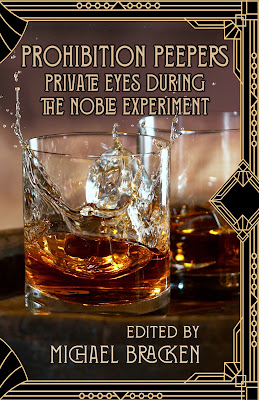The Top Fifteen Crime Films of the 1930s
by William Burton McCormick
Lists are silly. After all, these things are highly subjective.
But, as a writer, the process of making lists can be useful. Analyzing why you like something in narrative form, why it works, and why it does not work, can clarify your understanding of storytelling techniques. At least, that’s my excuse for doing it.
My other excuses? Well, I’m a classic film fan for one and enjoy digging into this old stuff. Lastly, I have a story called “Myrna Loy Versus the Third Reich” in the July/August issue of Ellery Queen’s Mystery Magazine. That story is set in 1938 and includes references to the motion pictures of that era. So, I thought it might be enjoyable to review some of the crime films of the 1930’s. And having watched them, (many for the tenth time or so), why not list them based on my personal preference? It’s more fun (for me at least) than giving you a list in alphabetical or chronological order.
So, here in reverse order are my top fifteen crime films from the decade of the 1930’s. Why fifteen? Well, narrowing it down to ten was too hard and twenty would make this essay too long. Also, inside the crime genre I include mystery, detective, police, espionage, gangster films and even the odd adventure or dramatic film if a crime is central to the plot. Also, there are spoilers here, so if you haven’t seen a film on the list, you might decide if you want to skip that entry. Here we go!

15. Manhattan Melodrama (1934)
Childhood buddies, Jim Wade (William Powell) and Blackie Gallagher (Clark Gable) remain true friends, despite being professionally and romantically at odds. Jim is an incorruptible district attorney; Blackie is a mob owner of speakeasies and gambling dens throughout Manhattan. Both love dancer Eleanor Packer (Myrna Loy). When Blackie does Jim an unsolicited favor and rubs out a man who could ruin Jim, it is Jim himself who indicts Blackie and sends him to the chair. Despite the criminal conviction, and losing Eleanor to Jim, Blackie’s gangster is glad to see his friend for a tearful goodbye moments before his execution.
Manhattan Melodrama was the second of seven pairings between Loy and Gable and the first of fourteen pairings between Loy and Powell (released only three weeks before The Thin Man, both films were smash hits ensuring future collaborations.) Manhattan Melodrama was the picture Loy-fan John Dillinger was attending when ambushed and shot down by police in Chicago, July 22, 1934. Loy criticized her studio, Metro-Goldwyn Mayer, for capitalizing on publicity from the killing.
14. The Man Who Knew Too Much (1934)
Alfred Hitchcock’s first classic of the sound era (he’d already produced a silent standout in The Lodger in 1927), The Man Who Knew Too Much tells the story of British couple Bob and Jill Lawrence (Leslie Banks and Edna Best) in Switzerland whose child is kidnapped by hostile agents.
Remade by Hitch himself in 1956 starring James Stewart and Doris Day, I prefer the original with its brisker pace, deadeye-with-a-rifle leading lady Jill and more memorable villain, Peter Lorre is his first English-speaking role.
13. Little Caesar (1931)
Edward G. Robinson became a star in his role as Rico “Little Caesar” Bandello, who climbs his way to the top of the mob only to come crashing down in fiery fashion. Along the way he drags his reluctant friend Joe Massara (Douglas Fairbanks, Jr.) in with him.
The film’s last line “Mother of mercy, is this the end of Rico?” is a cultural touchstone among gangster film fanatics to this day. Immensely influential on Scarface and countless other gangster films, one can definitely say Little Caesar’s finale was not the end of Rico.
12. The Most Dangerous Game (1932)
Fay Wray’s other landmark film was filmed simultaneously with King Kong on the same jungle sets. Wray and Bruce Armstrong filmed the Kong scenes in the day and The Most Dangerous Game scenes at night for what must have been exhausting parallel shoots.
Based on Richard Connell’s 1924 short story of the same name, the plot hinges on a big game hunter Count Zaroff (Leslie Banks) who decides to track and kill human prey as the ultimate test. Eve Towbridge (Wray) and Robert Rainsford (Joel McCrea) must survive unarmed on a jungle island while a rifle-carrying Zaroff pursues them. Imitated countless times but seldom surpassed.
11. The Kennel Murder Case (1933)
Before Nick Charles, William Powell played detective Philo Vance in four films from 1929 to 1933. The best of these is The Kennel Murder Case, an excellent locked room mystery about the killing of Archer Coe (Robert Barrat), the owner of a dog show champion who had bested Vance’s own pooch the day before.
Powell plays detective Vance so similar to his later Thin Man role, one could almost imagine these are the adventures of Nick Charles before he met Nora. The studios were so concerned that audiences would confuse Powell’s two detective roles that the first Thin Man film made a special trailer where Philo and Nick converse to set the record straight.
10. Sabotage (1936)
Alfred Hitchcock kicked the suspense into another gear with this tale of a foreign saboteur (Oscar Homolka) in London planning to blow up Piccadilly Circus. The saboteur’s wife (Sylvia Sydney), ignorant of his plot, begins to suspect more and more, especially when confronted by a British agent (John Loder) who also has romantic interest in her.
At one point, an innocent boy unknowingly carries a ticking bomb across London. Only Hitchcock could get away with what happens next.
9. Another Thin Man (1939)
William Powell and Myrna Loy return as Nick and Nora Charles in Another Thin Man, the third in the series. Colonel Burr MacFay (C. Aubrey Smith), who manages Nora’s family industries, is murdered in his Long Island mansion and the police think Nick is the culprit. Humor and adventure ensue.
Watch for the scene at a Latin nightclub where an amorous dancer won’t let Nora off the floor while a gregarious drunk interrupts Nick’s attempts at interviewing a suspect. Asta, baby Nick Jr., “fourth” Stooge Shemp Howard, and future television producer Sheldon Leonard complete the cast.
8. The Hound of the Baskervilles (1939)
The first and best of the fourteen Basil Rathbone Sherlock Holmes films, the story keeps reasonably close to Arthur Conan Doyle’s original (save for a séance scene, the change of relationship between a few characters, and a third act action twist).
20th Century Fox surpassed rival Universal with their use of atmosphere, the eerie landscape on the moors, the sense of creeping dread all around and the ability to recreate the chilling howls of a demonic hound out there somewhere… A perfect fusion of Gothic horror and British manor house mystery.
7. The Public Enemy (1931)
James Cagney forever defined himself as tough guy with The Public Enemy. His Irish-American gangster Tom Powers is an enforcer for the bootlegging industry with a thirst for vengeance against any man or beast who crosses him. An early sound picture, director William A Wellman put the new medium to maximum effect.
The film reverberates with haunting sounds: the gurgling last line of a singer killed mid chorus, the terrified whinnies of other horses when a race stallion is executed (yes, ‘executed’, not ‘put down’), the pulsating popping of beer barrels burst by machinegun bullets. In one darkly funny scene, Cagney uses a gun merchant’s own wares to rob him, a motif used again by Sergio Leone in The Good, the Bad and the Ugly. The denouement is a kicker like few others, nearly as memorable as White Heat years later. Jean Harlow is second billed here as Cagney’s love interest but has little screen time. It doesn’t matter, this was the most powerful gangster film Hollywood had yet made, one that still stirs ninety years later.
6. The Lady Vanishes (1938)
Possibly Alfred Hitchcock’s funniest film, The Lady Vanishes is the story of an elderly English governess Miss Foy (May Whitty) who vanishes on a moving train somewhere in central Europe.
British travelers Iris Henderson (Margaret Lockwood) and Gilbert (Michael Redgrave) search for her, exchanging put-downs and romantic-tinged barbs worthy of the best screwball comedies, while indifferent cricket-obsessed passengers Caldicott (Naunton Wayne) and Charters (Basil Radford) were hilarious enough to earn their own spinoff series (directed by others).
An enormous success on both sides of the Atlantic, The Lady Vanishes paved the way for Hitchcock to leave London for Hollywood two years later. The rest is cinematic history.
5. After the Thin Man (1936)
Probably the best mystery sequel ever filmed, many hardcore Thin Man fans consider this the finest in the series. And what’s not to love? Nick and Nora (William Powell and Myrna Loy again) return to San Francisco to find a New Year’s party raging in their house! Soon, Nora’s aristocratic family drags Nick into a mystery that devolves from a missing person to blackmail to murder.
With more time focused on Nick, Nora and Asta than the original, the humor and playful romance runs unabated throughout. My favorite scene is when Asta absconds with a clue and must be chased down by his hilariously frustrated owners. A young James Stewart costars. On a personal note, three reels of After the Thin Man play a key role in my aforementioned Ellery Queen’s Mystery Magazine story “Myrna Loy Versus the Third Reich.” So, this picture is something of an inspiration for me.
4. The Thin Man (1934)
But how can you surpass the original? When The Thin Man came out in 1934 it was something of a revolution. There had been comedic detective movies before, but none so witty. Bumbling sort of mystery comedies with clownish detectives and bungling thieves were the norm. Think Keystone Cops. The Thin Man, inspired by author Dashiell Hammett’s relationship with playwright Lillian Hellman, was as much a comedy of manners as a mystery.
Clever, teasing dialogue and the immense chemistry between Loy and Powell captured the minds of Depression-era movie goers. Before The Thin Man flirting and romance (on film) were trappings of courtship ending at the altar. Married couples were meant to be dignified and private with their affections – if they had them at all. But – shock! - Nick and Nora proved romance wasn’t dead after marriage. That married life could be sexy and adventurous, and maybe fun and funny.
The Charles’ relationship became the ideal to which many couples aspired. Once known for playing vamps and mob molls, Loy would be voted “The perfect wife” for years afterwards in national magazines. And, of course, with Prohibition ending only five months before, Nick and Nora were free to drink for an entire nation marooned on the wagon for fourteen years. Nominated for Best Picture and a runaway hit, The Thin Man was a release of pent-up frustrations in the mid-1930s. You can see its influence in every romantic sleuth couple since from Hart to Hart, Moonlighting, and countless sexually-entwined literary detective teams. Very close plot wise to Hammett’s original novel, the first film has the strongest mystery element of the series. Much screen time is spent developing the suspects, a rogues’ gallery of colorful oddballs, sycophants and weirdos. As Nora said at the climatic party: “Waiter, will you serve the nuts? I mean, will you serve the guests the nuts?”

3. Scarface (1932)
“The World is Yours,” folks. Directed by Howard Hawks, produced by Hawks and Howard Hughes, and with a screenplay by Ben Hecht, Scarface reigned for forty years as the undisputed greatest gangster movie ever made (until The Godfather arrived in ’72.) Taking the story of a ruthless mobster’s ascent similar to Little Caesar a year earlier, Hawks ratcheted up the violence to unprecedented levels and infused it with an operatic finale worthy of Greek tragedy.
At the heart of Scarface is Paul Muni’s electric performance as Tony Camonte, charismatic yet thoroughly terrifying in his pursuit of his twisted version of the American dream. Even Tony’s would-be-redeeming qualities, loyalty to his friend Guino (George Raft) and love of his sister Cesca (Ann Dvorak), turn to vengeful jealousy and incestuous control respectively by the end. A few of the comedy bits among Tony’s underlings are dated, but even those increase the movie’s effectiveness when those loveable buffoons are murdered in the third act thanks to Tony’s monomania. Watch too for Boris Karloff as a rival gang leader gunned down in a bowling alley. Brian de Palma’s 1983 remake with Al Pacino is good, but the original is the greater film. Not to be missed.

2. M (1931)
With all due respect to Metropolis and the wonderful film noirs Fritz Lang made for Hollywood in the 1940’s and ‘50’s, this is the Austrian director’s greatest picture. And one of the finest films ever made. The story of the manhunt for a child killer in Berlin, it melds unforgettable imagery and brilliant use of the then-new dimension of sound with social commentary. As the underworld and police both seek the killer, Lang hints that differences on either side of the law are not as distinct as some might like. And Peter Lorre’s performance as the murderer remains his greatest triumph, terrifying, unknowable, yet almost sympathetic during his speech before a kangaroo court of thugs who profess to try him. (He asserts essentially that these mobsters choose to be killers, while he is forced by sickness to kill. That their free will makes them – and by extension society – unfit to judge him.).
M’s influence is everywhere including my own novella A Stranger From the Storm. On weight of theme and sheer artistic merit, this is the greatest film on this list, but I can’t quite place it number one…
1. The 39 Steps (1935)
The definitive Hitchcock film (if not the best, though close to it.) Much like a British version of the later North by Northwest, our Canadian protagonist Richard Hannay (Robert Donat) is chased from London to the Scottish Highlands and back in the best “innocent man accused” story Hitch ever did. At a time when British films were inert and cerebral, The 39 Steps was lively, funny and swiftly-paced with a perfect twist ending. (No one will forget Mr. Memory (Wylie Watson), pun intended.) The British Film Institute named this the fourth greatest British film of all time, behind only The Third Man, Brief Encounter and Lawrence of Arabia. And none of those have the humor or breathtaking pace. Hitchcock took very little from the source novel by John Buchan, instead choosing to tell his own tale.

His success heralded the age where directors were no longer beholden to the novelist, but storytellers and artists in their own rights who could take what they wanted from a work and discard the rest. On a personal note, it galvanized me to visit the Scottish Highlands, write a story about the location “The House in Glamaig’s Shadow”, and in many ways inspired me to be a thriller novelist. One of a handful of movies, I could watch on endless loop into happy oblivion, The 39 Steps can’t be anything but number one on this list.
So, that was my Top 15 Crime Films of the 1930’s? What would be yours? Any major films or favorites I missed? Have you seen any of these? All of these? Please let me know in the comments below. And if you enjoyed this, I may make it a series (though a very intermittent one). Next would be the 1940’s, the era of the film noir. Can’t wait!
















.jpg)



















